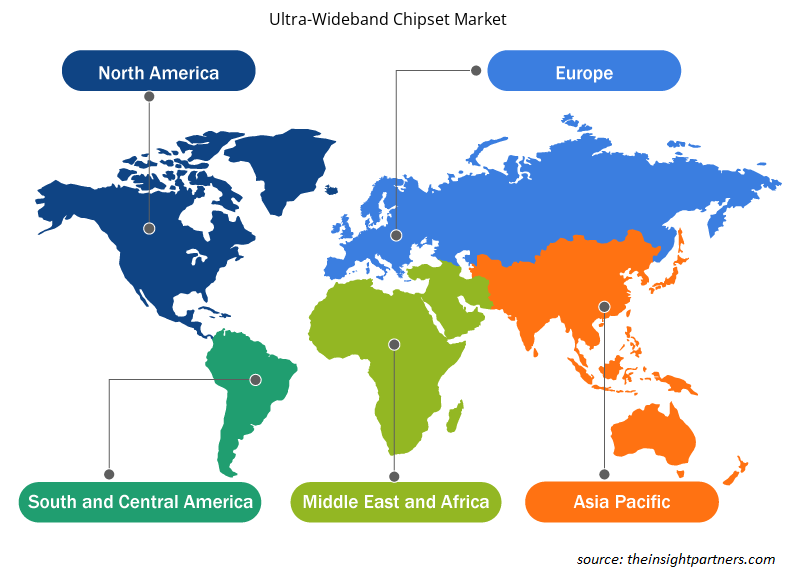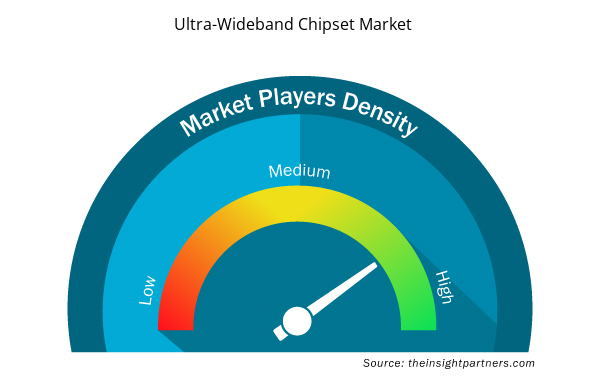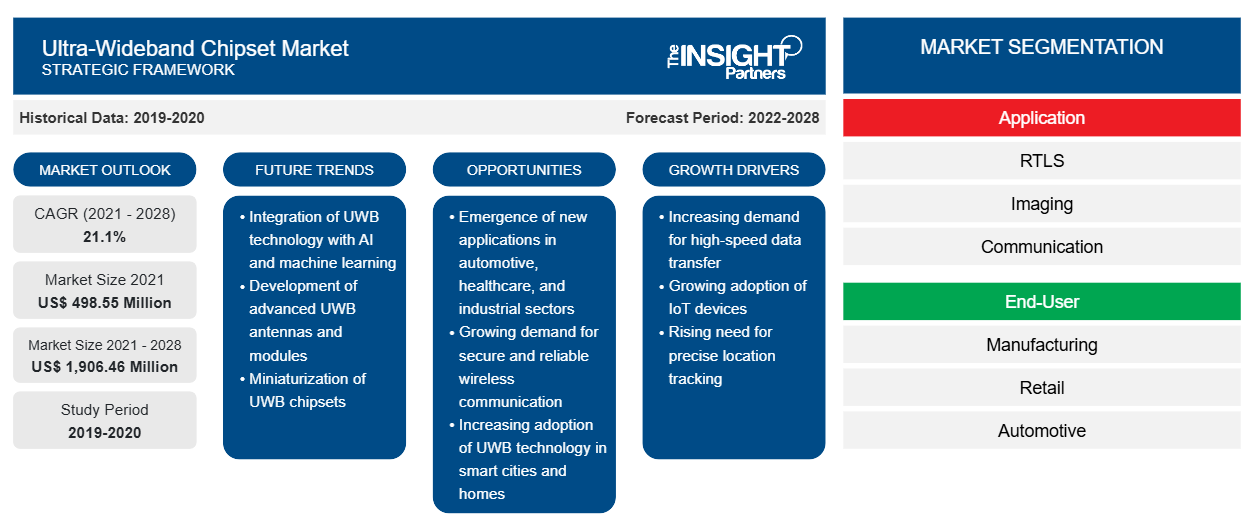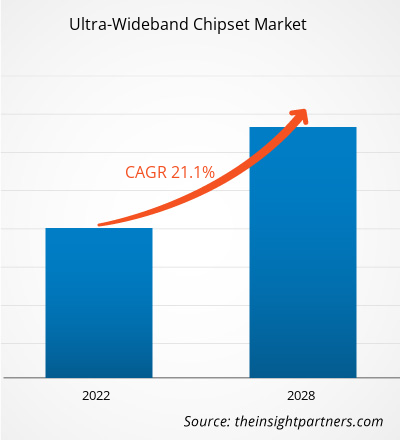El mercado de chipsets de banda ultra ancha se valoró en 498,55 millones de dólares en 2021 y se proyecta que alcance los 1.906,46 millones de dólares en 2028; se estima que crecerá a una CAGR del 21,1% entre 2021 y 2028.
La banda ultraancha es una de las tecnologías que se está adoptando cada vez más en los sistemas de localización en tiempo real (RTLS) y que tiene un potencial de crecimiento considerable debido a su mayor precisión en el seguimiento de objetos. La tecnología UWB ofrece una gran precisión, un amplio alcance y un menor consumo de energía que otras tecnologías RTLS, como RFID; esto ha llevado a una mayor penetración de la tecnología UWB en aplicaciones que requieren una gran precisión. Debido a esta mayor precisión de la tecnología UWB, varios usuarios finales de RTLS han pasado de RFID y Wi-Fi a la tecnología UWB para mejorar la eficiencia del producto. Además, las soluciones RTLS integradas con UWB ofrecen varias ventajas a las aplicaciones RTLS, impulsando así el mercado de los conjuntos de chips de banda ultraancha .
Personalice este informe según sus necesidades
Obtendrá personalización en cualquier informe, sin cargo, incluidas partes de este informe o análisis a nivel de país, paquete de datos de Excel, así como también grandes ofertas y descuentos para empresas emergentes y universidades.
- Obtenga las principales tendencias clave del mercado de este informe.Esta muestra GRATUITA incluirá análisis de datos, desde tendencias del mercado hasta estimaciones y pronósticos.
Impacto de la pandemia de COVID-19 en el tamaño del mercado de chipsets de banda ultraancha de Asia-Pacífico
Debido a la pandemia de COVID-19, varias regiones han sufrido mucho, especialmente la región de Asia y el Pacífico. Los sectores manufactureros de todo el mundo han experimentado una baja producción y una cadena de suministro más débil. Además, la escasez de mano de obra también ha afectado a la industria manufacturera. Las instalaciones de producción de sistemas basados en UWB también estuvieron cerradas o no pudieron producir una capacidad total, lo que ha afectado negativamente a los ingresos de las empresas desde 2020 hasta mediados de 2021 y ha dado lugar a un crecimiento más lento en el corto plazo. Sin embargo, con el creciente uso de la tecnología de monitorización remota, las herramientas de gestión de software podrían conducir a una mayor adopción durante el período posterior a la COVID. Por tanto, el impacto general de la COVID-19 en el mercado de chipsets de banda ultraancha en todo el mundo es de bajo a moderado.
Perspectivas de mercado: mercado de chipsets de banda ultraancha
La creciente adopción de la tecnología UWB en el seguimiento de dispositivos personales y de consumo impulsa el crecimiento del mercado de chipsets de banda ultraancha
La tecnología UWB mejora significativamente la experiencia del consumidor en productos de entretenimiento doméstico, como computadoras portátiles, televisores y equipos de audio. Esto ha llevado a una mayor adopción de la tecnología UWB y, en última instancia, impulsa el crecimiento del mercado de chipsets de banda ultraancha. También se está utilizando para rastrear artículos personales. Por ejemplo, el chip Apple U1 para la conciencia espacial está integrado en los iPhones 11, 12 y 13. Además, después de Apple, varios fabricantes de teléfonos inteligentes han integrado la tecnología UWB en sus productos, lo que contribuye al crecimiento del mercado de chipsets de banda ultraancha. Además, en abril de 2021, Apple lanzó AirTag con tecnología UWB, después de lo cual Samsung lanzó oficialmente su rastreador Galaxy SmartTag+ que comprende UWB. Por lo tanto, el aumento en la tasa de adopción contribuye al crecimiento del mercado de chipsets de banda ultraancha. significantly enhances the consumer experience of home entertainment products such as laptops, TV, and audio. This has led to increasing UWB technology adoption and eventually boosts the ultra-wideband chipset market growth. It is also being used to track the personal item. For example, the Apple U1 chip for spatial awareness is integrated into iPhones 11, 12, and 13. In addition, after Apple, various smartphone manufacturers have integrated UWB technology in their products, contributing to the growth of the ultra-wideband chipset market. Moreover, in April 2021, Apple released AirTag with UWB technology, post which Samsung officially launched its Galaxy SmartTag+ tracker comprising UWB. Thus, the surge in adoption rate contributes to the growth of the ultra-wideband chipset market.
Perspectivas basadas en aplicaciones
Según la oferta, el mercado de chipsets de banda ultraancha se segmenta en RTLS, imágenes y comunicación. El segmento de comunicaciones lideró el mercado en 2021. La comunicación inalámbrica UWB transmite una cantidad considerable de datos en un amplio espectro de frecuencias que va de 3,1 a 10,6 GHz. Incluye aplicaciones de medición de distancia, autenticación, USB inalámbrico y transferencia de datos. Además, la demanda de sistemas de comunicaciones inalámbricas de banda ancha ha aumentado significativamente, debido a aplicaciones emergentes como las redes móviles ad-hoc y la recopilación de datos a través de una red de sensores inalámbricos , lo que impulsa la demanda de un mercado de chipsets de banda ultraancha.ultra-wideband chipset market is segmented into RTLS, imaging, and communication. The communication segment led the market in 2021. UWB wireless communication transmits considerable data over a broad frequency spectrum ranging from 3.1 to 10.6 GHz. It includes ranging, authentication, wireless USB, and data transfer applications. Furthermore, the demand for wireless wideband communications systems has increased significantly, owing to emerging applications such as mobile ad-hoc networking and data collection through a ultra-wideband chipset market size.
El mercado de chipsets de banda ultraancha está segmentado en función de la aplicación, el usuario final y la geografía. Según el tipo, el mercado de chipsets de banda ultraancha se clasifica en sistemas de medición de imágenes y sistemas de medición sin imágenes. Según el usuario final, el mercado de chipsets de banda ultraancha se segmenta en fabricación, venta minorista, automoción, atención sanitaria y electrónica de consumo. Geográficamente, el mercado de chipsets de banda ultraancha está segmentado en América del Norte, Europa, Asia Pacífico (APAC) y el resto del mundo. ALEREON, INC.; Apple Inc.; Bespoon SAS; Decawave Limited; TAIYO YUDEN CO., LTD.; Taoglas; Johanson Technology, Inc.; NOVELDA; NXP Semiconductors NV; y Pulse-Link, inc. se encuentran entre los actores clave perfilados durante el estudio de mercado de chipsets de banda ultraancha.ultra-wideband chipset market is segmented based on application, end user, and geography. Based on type, the ultra-wideband chipset market is categorized into imaging measurement systems and non-imaging measuring systems. Based on end user, the ultra-wideband chipset market is segmented into manufacturing, retail, automotive, healthcare, and consumer electronics. Geographically, the ultra-wideband chipset market is segmented into North America, Europe, Asia Pacific (APAC), and the Rest of World. ALEREON, INC.; Apple Inc.; Bespoon SAS; Decawave Limited; TAIYO YUDEN CO., LTD.; Taoglas; Johanson Technology, Inc.; NOVELDA; NXP Semiconductors N.V.; and Pulse-Link, inc. are among the key players profiled during the ultra-wideband chipset market study.
Perspectivas regionales del mercado de chipsets de banda ultraancha Chipset Market Regional Insights
Los analistas de Insight Partners explicaron en detalle las tendencias y los factores regionales que influyen en el mercado de chipsets de banda ultraancha durante el período de pronóstico. Esta sección también analiza los segmentos y la geografía del mercado de chipsets de banda ultraancha en América del Norte, Europa, Asia Pacífico, Oriente Medio y África, y América del Sur y Central.

- Obtenga datos regionales específicos para el mercado de chipsets de banda ultra anchaUltra-Wideband Chipset Market
Alcance del informe sobre el mercado de chipsets de banda ultraancha
| Atributo del informe | Detalles |
|---|---|
| Tamaño del mercado en 2021 | US$ 498,55 millones |
| Tamaño del mercado en 2028 | US$ 1.906,46 millones |
| CAGR global (2021-2028) | 21,1% |
| Datos históricos | 2019-2020 |
| Período de pronóstico | 2022-2028 |
| Segmentos cubiertos | Por aplicación
|
| Regiones y países cubiertos | América del norte
|
| Líderes del mercado y perfiles de empresas clave |
|
Densidad de actores del mercado de chipsets de banda ultraancha: comprensión de su impacto en la dinámica empresarial
El mercado de chipsets de banda ultraancha está creciendo rápidamente, impulsado por la creciente demanda de los usuarios finales debido a factores como la evolución de las preferencias de los consumidores, los avances tecnológicos y una mayor conciencia de los beneficios del producto. A medida que aumenta la demanda, las empresas amplían sus ofertas, innovan para satisfacer las necesidades de los consumidores y aprovechan las tendencias emergentes, lo que impulsa aún más el crecimiento del mercado.
La densidad de actores del mercado se refiere a la distribución de las empresas o firmas que operan dentro de un mercado o industria en particular. Indica cuántos competidores (actores del mercado) están presentes en un espacio de mercado determinado en relación con su tamaño o valor total de mercado.
Las principales empresas que operan en el mercado de chipsets de banda ultra ancha son:
- ALEREON, INC.
- Compañía Apple Inc.
- Cuchara SAS
- Decawave limitada
- Compañía Taiyo Yuden Co., Ltd.
Descargo de responsabilidad : Las empresas enumeradas anteriormente no están clasificadas en ningún orden particular.

- Obtenga una descripción general de los principales actores clave del mercado de chipsets de banda ultra ancha
Los actores que operan en el mercado de chipsets de banda ultra ancha se centran principalmente en el desarrollo de productos avanzados y eficientes.
- En 2021, Apple Inc. lanzó AirTag con chipset U1 UWB diseñado para rastrear objetos usando iPhone.
- En 2020, Samsung lanzó su nuevo teléfono inteligente llamado Samsung Galaxy Note20 Ultra, que funciona con el chipset de banda ultra ancha de NXP Semiconductors.
- Análisis histórico (2 años), año base, pronóstico (7 años) con CAGR
- Análisis PEST y FODA
- Tamaño del mercado Valor/volumen: global, regional, nacional
- Industria y panorama competitivo
- Conjunto de datos de Excel



Report Coverage
Revenue forecast, Company Analysis, Industry landscape, Growth factors, and Trends

Segment Covered
This text is related
to segments covered.

Regional Scope
North America, Europe, Asia Pacific, Middle East & Africa, South & Central America

Country Scope
This text is related
to country scope.
Preguntas frecuentes
The automotive and transportation industry has witnessed a series of new and emerging UWB technology applications for the past few years and wireless technology is majorly used in automobiles for radio reception and navigation purposes. Additionally, the introduction of advanced features in cars such as keyless entry and tire pressure monitoring has also led to the higher adoption of wireless data transmission techniques which will create growth opportunities of the market during the forecast period.
Ongoing advancements in new application areas of UWB technology in the wireless sensor network and growing deployment of the technology in mobile devices have increased the scope of UWB technology. Furthermore, UWB is one of the fastest-growing technologies adopted in RTLS systems, with a considerable growth potential due to its accuracy in tracking assets. UWB technology and the next-generation BLE beacon technology are likely to be in demand by the providers of RTLS solutions and asset tracking systems during the forecast period. Thus, the adoption of RTLS (real-time location system) of ultra-wideband chipsets to track or locate people or objects within confined areas such as shopping malls, hospitals, and airports is expected to boost the global ultra-wideband (UWB) chipset market during the forecast period.
The communication segment is expected to dominate the market during the forecast period. UWB communication utilizes wide bandwidth and supports high data rates. UWB wireless communication transmits a huge amount of data over a wide frequency spectrum between 3.1 to 10.6GHz. It includes applications such as ranging, authentication, wireless USB, data transfer. USB UWB communication mainly uses low-powered radio signals of short pulses for the transmission and reception of data. Recently, ultra-wideband antenna applications have grown to include a wide range of computing devices and Internet of Things (IoT) peripherals. Most of these wireless communication systems employ a UWB antenna for data transmission, reception, positioning, location identification, sensing, and tracking. Depending on the radiation characteristics of the communication system, UWB antenna design varies, and each application requires customized UWB antennas. Thus, the above factor will lead market players to invest more on development of the products.
Ultra-wideband technology is considered to be the fastest-growing technology, which is predicted to notably enhance the consumers experience related to smartphones, TVs, home entertainment products, audio equipment, and laptops. UWB is known for offering wireless connections at speeds of around 110 Mbit/sec and higher, thus making it suitable for connecting televisions to recorders and DVD players, home audio equipment, and personal video recorders (PVRs). UWB is able to meet the low power requirements of handheld electronics and offers a low-cost solution that is relevant for wide consumer adoption. The major use of UWB chipsets is expected to be across smartphones, wearable, Ipad, homepod, and mini watches. The devices that are equipped with the Apple-designed U1 chip feature ultra-Wideband technology for spatial awareness. UWB is available for iPhone 11, iPhone 12, and iPhone 13 variants. UWB is not available in all the countries of the world and is subject to international regulatory requirements. In the consumer electronics sector, the use of UWB technology is anticipated to be the most for smartphones.
In 2020, Asia Pacific holds the largest share of the global ultra-wideband chipset market owing to the integration of UWB technology in consumer electronic devices for RTLS, imaging, and communication. China leads the region due to the heavy investments in research and development of UWB technology. Moreover, the increasing healthcare industry in the region and the need for highly accurate imaging and detection systems are among the factors driving the market growth.
NXP Semiconductors, Qorvo, Decaware, Alereon and Apple are the five key market players operating in the Global Ultra-Wideband Chipset Market. listing of Key Five Players in the Global Ultra-Wideband Chipset Market by giving weightage to following key parameters: overall revenue, segmental revenue, brand image & industry experience, current automatic tolling system portfolio, innovative and advanced technology integration/material enhancements, customer base, geographical reach, new product launches, partnerships, mergers & acquisitions, and other market related activities.
Trends and growth analysis reports related to Electronics and Semiconductor : READ MORE..
The List of Companies - Ultra Wideband Chipset Market
- ALEREON, INC.
- Apple Inc.
- Bespoon SAS
- Decawave Limited
- TAIYO YUDEN CO., LTD.
- Johanson Technology, Inc.
- NOVELDA AS
- NXP Semiconductors N.V.
- Pulse-Link, inc.
- Taoglas
The Insight Partners performs research in 4 major stages: Data Collection & Secondary Research, Primary Research, Data Analysis and Data Triangulation & Final Review.
- Data Collection and Secondary Research:
As a market research and consulting firm operating from a decade, we have published and advised several client across the globe. First step for any study will start with an assessment of currently available data and insights from existing reports. Further, historical and current market information is collected from Investor Presentations, Annual Reports, SEC Filings, etc., and other information related to company’s performance and market positioning are gathered from Paid Databases (Factiva, Hoovers, and Reuters) and various other publications available in public domain.
Several associations trade associates, technical forums, institutes, societies and organization are accessed to gain technical as well as market related insights through their publications such as research papers, blogs and press releases related to the studies are referred to get cues about the market. Further, white papers, journals, magazines, and other news articles published in last 3 years are scrutinized and analyzed to understand the current market trends.
- Primary Research:
The primarily interview analysis comprise of data obtained from industry participants interview and answers to survey questions gathered by in-house primary team.
For primary research, interviews are conducted with industry experts/CEOs/Marketing Managers/VPs/Subject Matter Experts from both demand and supply side to get a 360-degree view of the market. The primary team conducts several interviews based on the complexity of the markets to understand the various market trends and dynamics which makes research more credible and precise.
A typical research interview fulfils the following functions:
- Provides first-hand information on the market size, market trends, growth trends, competitive landscape, and outlook
- Validates and strengthens in-house secondary research findings
- Develops the analysis team’s expertise and market understanding
Primary research involves email interactions and telephone interviews for each market, category, segment, and sub-segment across geographies. The participants who typically take part in such a process include, but are not limited to:
- Industry participants: VPs, business development managers, market intelligence managers and national sales managers
- Outside experts: Valuation experts, research analysts and key opinion leaders specializing in the electronics and semiconductor industry.
Below is the breakup of our primary respondents by company, designation, and region:

Once we receive the confirmation from primary research sources or primary respondents, we finalize the base year market estimation and forecast the data as per the macroeconomic and microeconomic factors assessed during data collection.
- Data Analysis:
Once data is validated through both secondary as well as primary respondents, we finalize the market estimations by hypothesis formulation and factor analysis at regional and country level.
- Macro-Economic Factor Analysis:
We analyse macroeconomic indicators such the gross domestic product (GDP), increase in the demand for goods and services across industries, technological advancement, regional economic growth, governmental policies, the influence of COVID-19, PEST analysis, and other aspects. This analysis aids in setting benchmarks for various nations/regions and approximating market splits. Additionally, the general trend of the aforementioned components aid in determining the market's development possibilities.
- Country Level Data:
Various factors that are especially aligned to the country are taken into account to determine the market size for a certain area and country, including the presence of vendors, such as headquarters and offices, the country's GDP, demand patterns, and industry growth. To comprehend the market dynamics for the nation, a number of growth variables, inhibitors, application areas, and current market trends are researched. The aforementioned elements aid in determining the country's overall market's growth potential.
- Company Profile:
The “Table of Contents” is formulated by listing and analyzing more than 25 - 30 companies operating in the market ecosystem across geographies. However, we profile only 10 companies as a standard practice in our syndicate reports. These 10 companies comprise leading, emerging, and regional players. Nonetheless, our analysis is not restricted to the 10 listed companies, we also analyze other companies present in the market to develop a holistic view and understand the prevailing trends. The “Company Profiles” section in the report covers key facts, business description, products & services, financial information, SWOT analysis, and key developments. The financial information presented is extracted from the annual reports and official documents of the publicly listed companies. Upon collecting the information for the sections of respective companies, we verify them via various primary sources and then compile the data in respective company profiles. The company level information helps us in deriving the base number as well as in forecasting the market size.
- Developing Base Number:
Aggregation of sales statistics (2020-2022) and macro-economic factor, and other secondary and primary research insights are utilized to arrive at base number and related market shares for 2022. The data gaps are identified in this step and relevant market data is analyzed, collected from paid primary interviews or databases. On finalizing the base year market size, forecasts are developed on the basis of macro-economic, industry and market growth factors and company level analysis.
- Data Triangulation and Final Review:
The market findings and base year market size calculations are validated from supply as well as demand side. Demand side validations are based on macro-economic factor analysis and benchmarks for respective regions and countries. In case of supply side validations, revenues of major companies are estimated (in case not available) based on industry benchmark, approximate number of employees, product portfolio, and primary interviews revenues are gathered. Further revenue from target product/service segment is assessed to avoid overshooting of market statistics. In case of heavy deviations between supply and demand side values, all thes steps are repeated to achieve synchronization.
We follow an iterative model, wherein we share our research findings with Subject Matter Experts (SME’s) and Key Opinion Leaders (KOLs) until consensus view of the market is not formulated – this model negates any drastic deviation in the opinions of experts. Only validated and universally acceptable research findings are quoted in our reports.
We have important check points that we use to validate our research findings – which we call – data triangulation, where we validate the information, we generate from secondary sources with primary interviews and then we re-validate with our internal data bases and Subject matter experts. This comprehensive model enables us to deliver high quality, reliable data in shortest possible time.


 Obtenga una muestra gratuita de este informe
Obtenga una muestra gratuita de este informe